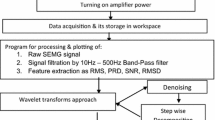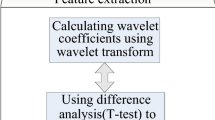Wavelet analysis of surface electromyogram (sEMG) signals has been investigated. Methods to remove noise before processing and further analysis are rather significant for these signals. The sEMG signals were estimated with the following steps, first, the obtained signal was decomposed using wavelet transform; then, decomposed coefficients were analyzed by threshold methods, and, finally, reconstruction was performed. Comparison of the Daubechies wavelet family for effective removing noise from the recorded sEMGs was executed preciously. As was found, wavelet transform db4 performs denoising best among the aforesaid wavelet family. Results inferred that Daubechies wavelet families (db4) were more suitable for the analysis of sEMG signals related to different upper limb motions, and a classification accuracy of 88.90% was achieved. Then, a statistical technique (one-way repeated factorial analysis) for the experimental coefficient was done to investigate the class separ ability among different motions.
Similar content being viewed by others
References
J. Kilby and H. G. Hosseini, “Extracting effective features of SEMG using continuous wavelet transform,” Conf. Proc. IEEE Eng. Med. Biol. Sci., 1, 1704-1707 (2006).
H. S. Ryait, A. S. Arora, and R. Agarwal, “Interpretations of wrist operations from surface-EMG signals at different locations on arm along with acupressure points,” IEEE Transact. Biomed. Circ. Syst., 4, No. 2, 101-111 (2010).
Q. Zhang and Zh. Luo, “Wavelet de-noising of electromyography,” in: Proc. IEEE Internat. Conf. Mechatron. Automat. (June 25 - 28, 2006), China (2006), pp. 1553-1558.
K. A. Wheeler, H. Shimada, D. K. Kumar, and S. P. Arjunan, “A sEMG model with experimentally based simulation parameters,” Conf. Proc. IEEE Eng. Med. Biol. Soc., 4258-4261 (2010).
N. M. Sobahi, “Denoising of EMG signals based on wavelet transform,” Asian Transact. Eng., 1, No. 5, 17-23 (2011).
A. Phinyomark, A. Nuidod, P. Phukpattaranont, and C. Limsakul, “Feature extraction and reduction of wavelet transform coefficients for EMG pattern classification,” Electron. Electr. Eng. Signal Technol., 6, 27-32 (2012).
A. Phinyomark, C. Llimsakul, and P. Phukpattaranont, “Optimal wavelet functions in wavelet denoising for multifunction myoelectric control,” ECTI Transact. Electr. Eng. Electron. Commun., 8, 43-52 (2010).
A. Phinyomark, C. Llimsakul, and P. Phukpattaranont, “Application of wavelet analysis in EMG feature extraction for pattern classification,” Measur. Sci. Rev., 11, 45-52 (2011).
K. Englehart, B. Hudgins, and P. A. Parker, “A waveletbased continuous classification scheme for multifunction myoelectric control,” IEEE Transact. Biomed. Eng., 48, No. 3, 302-311 (2001).
M. Lascu and D. Lascu, “Graphical programming based biomedical signal acquisition and processing,” Int. J. Circ. Syst. Sign. Proc., 1, No. 4, 317-326 (2007).
R. L. Ortolan, R. N. Mori, R. R. Pereira, et al., “Evaluation of adaptive/nonadaptive filtering and wavelet transform techniques for noise reduction in EMG mobile acquisition equipment,” IEEE Transact. Neural Syst. Rehabil. Eng., 11, No. 1, 60-69 (2010).
C. F. Jiang and S. L. Kuo, “A comparative study of wavelet denoising of surface electromyographic signals,” Conf. Proc. IEEE Eng. Med. Biol. Sci., 1868-1871 (2007).
X. Zhang, Y. Wang, and R. P. S. Han, “Wavelet transform theory and its application in EMG signal processing,” 7th Int. Conf. Fuzzy Syst. Knowl. Discov. (Aug 23-26, 2010), 6 (2010).
S. Micera, “Control of hand prostheses using peripheral information,” IEEE Rev. Biomed. Eng., 3, 48-68 (2010).
K. Englehart, B. Hudgins, P. A. Parker, and M. Stevenson, “Classification of the myoelectric signal using time-frequency based representations,” Med. Eng. Phys., 21, Nos. 6/7, 431-438 (1999).
A. Phinyomark, P. Phukpattaranont, C. Limsakul, et al., “The usefulness of mean and median frequencies in electromyography analysis,” in: Computational Intelligence in Electromyography Analysis – A Perspective on Current Applications and Future Challenges, G. R. Naik (ed.), InT ech, Chap. 8 (2012).
C. J. De Luca, M. A. Sabbahi, and S. H. Roy, “Median frequency of the myoelectric signal: Effect of hand dominance,” Eur. J. Appl. Physiol. Occup. Physiol., 55, No. 5, 457-464 (1986).
Sh. J. Coakers, SPSS Version 12.0 for Windows, Analysis Without Anguish, John Wiley Sons Publ., Australia (2005), p. 88.
Author information
Authors and Affiliations
Corresponding author
Rights and permissions
About this article
Cite this article
Karan, V. Wavelet Transform-Based Classification of Electromyogram Signals Using an Anova Technique. Neurophysiology 47, 302–309 (2015). https://doi.org/10.1007/s11062-015-9537-7
Received:
Published:
Issue Date:
DOI: https://doi.org/10.1007/s11062-015-9537-7




